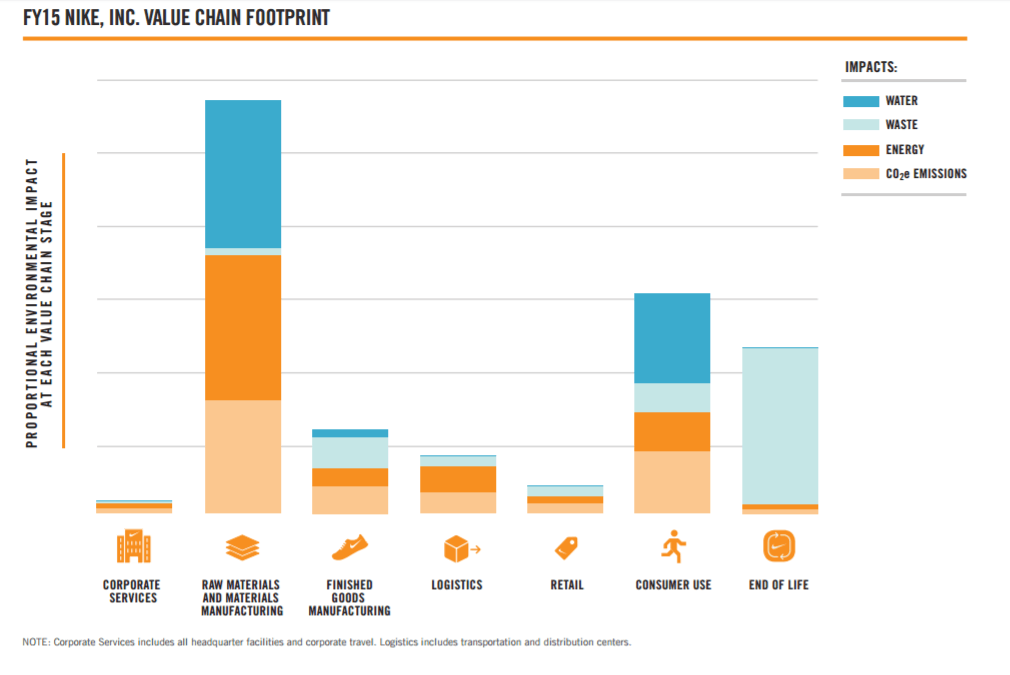Running to Discover Sustainable Solutions: How Nike is Fighting to Win the Climate Change Game

How can a company shift from the brink of reputational ruin to the forefront of sustainability? This post presents Nike's climate change journey over the past two decades and explores where it must go next.
In 1998 Chairman and CEO of Nike, Phil Knight, said, “The Nike product has become synonymous with slave wages, forced overtime and arbitrary abuse [1].” Today Nike is recognized as a leader of sustainability in the retail industry, signing the White House pledge against climate change, and even experiencing ratings upgrades from Wall Street analysts based on their sustainability performance [2] [3]. While their reputation has clearly made a U-turn, the question remains: can Nike take their game to the next level?
The League: Retail’s Role in Climate Change
The retail industry is at a unique intersection of opportunity and threat from climate change. Some threats are immediately apparent: adverse weather events caused by climate change may result in store or factory closures translating to immediate sales loss. Nike experienced this in 2008 when flooding in Thailand caused temporary closure of four factories, while companies such as IKEA, impacted by Hurricane Sandy in 2012, lost $9M from store closures [4] [5]. Less apparent threats include the upstream impact of availability of raw materials as well as regulations impacting operational practices including energy efficiency, water use, and the disposal of waste [6] [7]. While risky to retailers’ business models, these threats also translate into opportunities to differentiate and develop reputational advantage.
The Game Plan: Nike Sustainability Initiatives
Since the late 1990s Nike has worked to embed environmental and labor related metrics into the structure of the organization; Chief Sustainability Officer, Hannah Jones, describes this journey, “[sustainability] moved from being a risk and reputation function to being a business lever function to being an innovation function [8].” Today the company looks at impact across its entire value chain on an ongoing basis. Figure 1 below from Nike’s 2014/2015 Sustainable Business Report depicts the proportional environmental impact of each step in Nike’s value chain.
Figure 1 [9]
This figure highlights where in the value chain Nike has decided to focus its climate change efforts:
- Raw Materials: CSO Hannah Jones spearheaded efforts to leverage design as one of Nike’s primary tools to combat climate change. One industry observer noted, “rather than monitor the use of facial masks by overseas workers handling toxic chemicals, Nike is teaching itself to design shoes that don’t use them [10].” Beginning with switching the gas in the sole of the Nike Air shoe from FS6, a greenhouse gas, to nitrogen, Nike has engaged on a path of sustainable innovation [11]. More recent achievements include using 19% BCI-certified (industry accredited standard setting body) cotton and making 39% of polyester garments from recycled materials [12].
- Materials Manufacturing: With well over 500 vendors, Nike’s challenge in manufacturing is often one of control. To incentivize vendors to partner with Nike in reducing energy use, emissions, waste, and water use, they have designed Nike-specific programs and partnered with manufacturers to develop new technologies. One example of this innovative approach is Nike’s partnership with a startup to use supercritical carbon dioxide instead of water to dye textiles – saving some of the three billion gallons of water a year it previously used for this process [13]. More recent achievements include 20% reduction in CO2E emissions per unit from contract footwear manufacturers and 43% per unit water use reduction in footwear manufacturing [14].
The After-Action Review: Next Steps for Nike
Despite Nike’s sustainable efforts, some critics, such as the environmental activist NGO, Greenpeace, claim that Nike is still underperforming compared to peer organizations [15]. I believe there are several key areas of improvement Nike can focus on in the future:
- Consumer: Figure 1 demonstrates that consumer use represents the second highest percentage of environmental impact in Nike’s value chain. While Nike cannot control consumer use, it can work to better educate consumers. For example, H&M has helped customers recycle 25,000 tons of their unwanted clothes since launching its Garment Collecting initiative in 2013 [16].
- Transportation: Logistics also contributes a substantial percentage to Nike’s environmental impact. While there are again issues of supply chain control, Nike could take a more active role in minimizing transportation impact as it ships, drives, and flies its goods all over the world. Companies such as PepsiCo have deployed all-electric delivery trucks, which emit 75% less greenhouse gases than diesel [17].
- Metrics: As Greenpeace calls out Nike’s metrics could benefit from additional specificity and transparency. Many of their sustainability goals use terms such as “more sustainable” or “Vendors Active in Nike Water Program.” Nike should explore using more external accrediting agencies and quantitative metrics going forward.
As one of the most globally influential brands, Nike has a responsibility to the globe to keep the ball rolling on the critically important topic of climate change.
(772 Words)
Sources:
[1] Kate Abnett, “Just Fix It: How Nike Learned to Embrace Sustainability,” Business of Fashion, November 1, 2016, https://www.businessoffashion.com/articles/people/just-fix-it-hannah-jones-nike, accessed November 2016.
[2] Demetri Sevastopulo and Barney Jopson, “Global companies sign White House pledge on climate change action,” Financial Times, October 19, 2015, https://www.ft.com/content/ed2c2682-763a-11e5-933d-efcdc3c11c89, accessed November 2016.
[3] Andrew Winston, “Luxury Brands Can No Longer Ignore Sustainability,” Harvard Business Review, February 8, 2016, https://hbr.org/2016/02/luxury-brands-can-no-longer-ignore-sustainability, accessed November 2016.
[4] Coral Davenport, “Industry Awakens to Threat of Climate Change,” New York Times, January 23, 2014, http://www.nytimes.com/2014/01/24/science/earth/threat-to-bottom-line-spurs-action-on-climate.html?_r=3, accessed November 2016.
[5] Ikea, “Ikea Group position on climate and energy,” http://www.ikea.com/ms/en_US/pdf/reports-downloads/IKEA_Group_position_on_climate_and_energy.pdf, accessed November 2016.
[6] PWC, “Building value by addressing the impact of climate change,” Retail & Consumer Insights: Megatrends in the Retail and Consumer Products Industry, June 2015, https://www.pwc.com/us/en/retail-consumer/publications/assets/rc-insights-climate-change.pdf, accessed November 2016.
[7] Rebecca Henderson, Richard M. Locke, Christopher Lyddy, Cate Reavis, “Nike Considered: Getting Traction on Sustainability,” MIT No. 08-077 (Boston: MIT Sloan Management, 2009), https://mitsloan.mit.edu/LearningEdge/CaseDocs/08.077.Nike%20Considered.Getting%20Traction%20on%20Sustainability.Locke.Henderson.pdf, accessed November 2016.
[8] Abnett, “Just Fix It: How Nike Learned to Embrace Sustainability,” Business of Fashion
[9] Nike, FY14/15 Sustainable Business Report, p. 23, http://news.nike.com/news/sustainable-innovation, accessed November 2016.
[10] Henderson, Locke, Lyddy, Reavis, “Nike Considered: Getting Traction on Sustainability,” MIT
[11] Abnett, “Just Fix It: How Nike Learned to Embrace Sustainability,” Business of Fashion
[12] Nike, FY14/15 Sustainable Business Report, p. 28
[13] Elizabeth Woyke, “What does a Chief Sustainability Officer do?,” MIT Technology Review, Vol. 119, No. 4, p. 101-102
[14] Nike, FY14/15 Sustainable Business Report, p. 36, 44
[15] Greenpeace, “The Detox Catwalk 2016: Who’s on the path to toxic free fashion?,” http://www.greenpeace.org/international/en/campaigns/detox/fashion/detox-catwalk/, accessed November 2016.
[16] H&M, “This is World Recycle Week,” April 2016, http://www.hm.com/us/magazine/culture/h-m-inside/2016/04/this-is-world-recycle-week, accessed November 2016.
[17] PWC, “Building value by addressing the impact of climate change”
Images:
Image 1: Close the Loop, “Nike,” http://close-the-loop.be/en/case/33/nike, accessed November 2016.
Image 2: Nike 2014/2015 Sustainable Business Report, p.23




It is curious that the thing that I would think Nike has the most control over – waste – doesn’t have an explicit initiative dedicated to it. By changing the mix of their product, with the intent manufacturing a more biodegradable product, they could materially improve their global waste footprint.
Also, I would be curious as to whether Nike is committed enough to the cause of sustainability to charge a premium on each of their sneakers to offset their manufacturing footprint. I am sure that a company with the historical success of Nike would have already reduced waste throughout their procurement, manufacturing, and distribution models in order to maximize profits so any further commitment to sustainability would like have to come with an additional cost or fee charged to the customer.
Thanks for the great post on a very visible consumer business! It’s great to see how diligent Nike has been about zeroing in on the environmental costs of each arm of their business, and even through the lifecycle of their products. Cynically, I wonder if some the increased focus around initiatives like this is an attempt to proactively get ahead of public relations concerns about their business since those have gotten out of control for them in the past.
The last point you identify around metrics is especially interesting to me. I agree that as one of the world’s most influential and recognizable brands Nike should be stepping up as a leader in sustainability issues – with clear goals and programs that offer transparency to consumers and shareholders. There is something moderately condescending about organizations offering lip service to a cause, without really demonstrating how much skin they have in the game – either with performance goals, clear measures and transparency, or how much capital they are putting behind this. It seems like the organization is moving in the right direction, but Nike has more work to do if they’d like to prove their dedication to these causes.
Awesome post – I love the chart you have from Nike that the relative environmental impact of each step of the value chain. To me, the most surprising part of the data was the amount of impact that occurs following purchase.
I know Nike has some initiatives (e.g., Reuse-a-Shoe program), and agree that this is a really interesting area for them to continue to explore as they expand their (ambitious) sustainability plans. I think focusing efforts at this step of the value chain (rather than at design at the front-end) may ultimately prove to be a better strategy if results in less of a trade-off for consumers (i.e., between sustainability and price/product). Looking forward to see what Nike has in store for the future!
Great post on Nike! I recall from the Nike case that the company used recycled plastic bottles to manufacture soccer jerseys, and to quote a case protagonist: “Ultimately, I don’t want you to buy it because it’s a sustainable product; I want you to buy it because it is the best product out there.” Its both rare and challenging to excel at sustainability and at product quality at the same time. Given these dual goals, Nike likely must spend quite a bit on R&D in order to achieve both goals, and your graphic on metrics confirms that is the case. Although Nike sets a high bar and a model for other companies to integrate sustainability with product, this pairing is ultimately reflected as high environmental costs in the value chain (manufacturing), and is passed along in part or in whole via high consumer prices. Interesting to see how these and other sustainability initiatives help to reduce the overall footprint at the manufacturing stage.